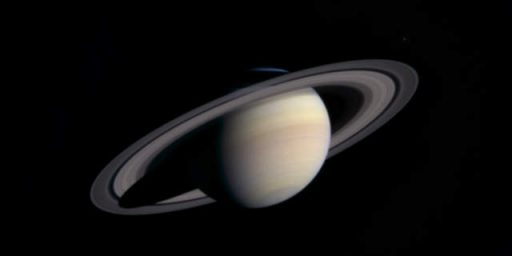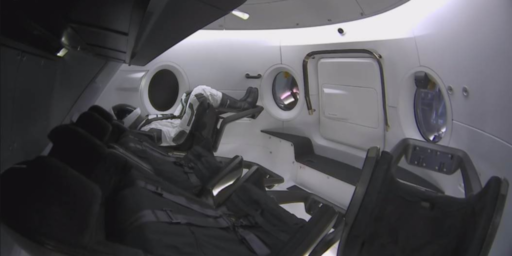Kepler Space Telescope May Be Finished
The Kepler Space Telescope, which has aided in the discovery of hundreds of planets orbiting other stars, may be permanently damaged:
NASA’s planet-hunting Kepler telescope is broken, potentially jeopardizing the search for other worlds where life could exist outside our solar system.
If engineers can’t find a fix, the failure could mean an end to the $600 million mission’s search, although the space agency wasn’t ready to call it quits Wednesday. The telescope has discovered scores of planets but only two so far are the best candidates for habitable planets.
“I wouldn’t call Kepler down-and-out just yet,” said NASA sciences chief John Grunsfeld.
NASA said the spacecraft lost the second of four wheels that control its orientation in space. With only two working wheels left, it can’t point at stars with the same precision.
In orbit around the sun, 40 million miles from Earth, Kepler is too far away to send astronauts on a repair mission like the way Grunsfeld and others fixed a mirror on the Hubble Space Telescope. Over the next several weeks, engineers on the ground will try to restart Kepler’s faulty wheel or find a workaround. The telescope could be used for other purposes even if it can no longer track down planets.
Kepler was launched in 2009 in search of Earth-like planets. So far, it has confirmed 132 planets and spotted more than 2,700 potential ones. Its mission was supposed to be over by now, but last year, NASA agreed to keep Kepler running through 2016 at a cost of about $20 million a year.
Just last month, Kepler scientists announced the discovery of a distant duo that seems like ideal places for some sort of life to flourish. The other planets found by Kepler haven’t fit all the criteria that would make them right for life of any kind – from microbes to man.
While ground telescopes can hunt for planets outside our solar system, Kepler is much more advanced and is the first space mission dedicated to that goal.
For the past four years, Kepler has focused its telescope on a faraway patch of the Milky Way hosting more than 150,000 stars, recording slight dips in brightness – a sign of a planet passing in front of the star.
Now “we can’t point where we need to point. We can’t gather data,” deputy project manager Charles Sobeck told The Associated Press.
Scientists said there’s a backlog of data that they still need to analyze even if Kepler stopped looking for planets.
“I think the most interesting, exciting discoveries are coming in the next two years. The mission is not over,” said chief scientist William Borucki at the NASA Ames Research Center in Northern California, which manages the mission.
This is truly unfortunate news. Hopefully, they’ll be able to get it functioning again.






Sky and Telescope is saying the same thing, and that it’s a problem they’ve been worried about for a while. It will take a couple of months to find out for sure if there’s nothing they can do, but it’s not looking good.
Kepler still did pretty well, since the original mission was for four years (it got an extension) after being launched in 2009. We’ve gotten lucky with a number of space probes and telescopes lasting way longer than the planned mission life expectancy (Mars Opportunity Rover), but it looks like that’s not going to happen with Kepler.
The upside is that they still have a vast amount of data to search through for potential planets, and Kepler was observing long enough to get potentially three transits for confirming an earth-like planet around a sun-like star. It will probably take them 1-2 years to scour the existing data, so they’ve got lots to work on.
Now if we could just get James Webb Space Telescope up there . . .
Actually, I might be wrong on part of that. S & T made a point about the Kepler Mission Extension that I missed on first reading:
@Brett: Did budget cuts have any effect on the durability of these projects? Did things last longer in the past because they were overbuilt thanks to a more generous budget?
In spite of this setback, the mission was overall, another smashing success for NASA. If there was ever an agency that deserves a bigger budget, this is one.
@anjin-san: I agree whole heartily. NASA has been a major success as an organization in general. Lot of good paying jobs for local and not so local Americans thanks to that Agency.
@ Matt
There are vast opportunities waiting for us beyond earth’s atmosphere. We just need to adjust our thinking and repurpose space travel around economic benefits, not political ones. The scientific benefits will continue. We should be going all out to build a better space station, create better propulsion systems, and begin to exploit the resources that asteroids offer.
The future is waiting for us, if we can recapture the vision we seem to have lost recently.
@Matt:
No, and yes. Kepler was being built when NASA budgets were still pretty big. And they try to use as much off-the-shelf tech as possible. But, a couple of decade ago, NASA began to emphasize smaller missions (SMEX and MIDEX explorers as we call them) that are cheaper and more focused than the Great Observatories.
@Hal 10000: Yeah I observed that (I live kind of near Houston and know some people there).
@anjin-san: many MANY thumbs up
I wonder if it would have been possible to build in redundancy foe these wheels. How many moving parts did the telescope have?
@Ben Wolf: The wheel and motor assemblies are too heavy to build on much redundancy without seriously breaking the budget. There’s not a bad possibility they can revive one of the two failed wheels over time, maybe thermally conditioning the thing before some back and forths among other clever ideas.
@Ben Wolf:
You try to build as much redundancy as you can. HST, for example, has 6 gyros but only needs three and can technically operate on two. But with any mission — especially a rocket mission like Kepler — you have a very strict weight limit.